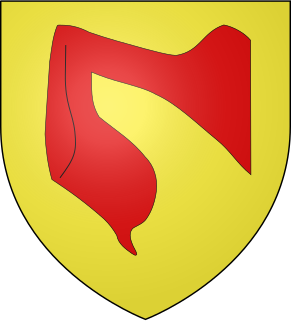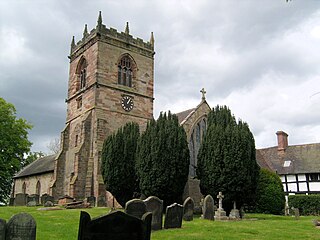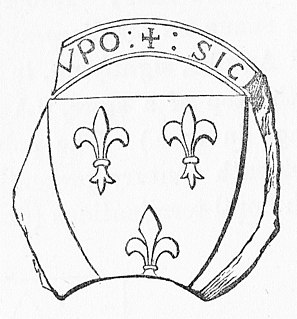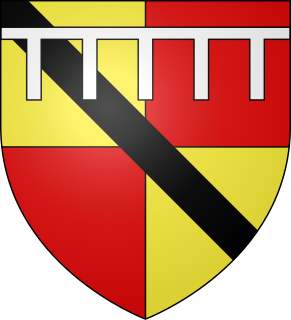Related Research Articles

William III de Cantilupe was the 3rd feudal baron of Eaton Bray in Bedfordshire, and jure uxoris was feudal baron of Totnes in Devon and Lord of Abergavenny. His chief residences were at Calne in Wiltshire and Aston Cantlow, in Warwickshire, until he inherited Abergavenny Castle and the other estates of that lordship.

Miles FitzWalter of Gloucester, 1st Earl of Hereford was a great magnate based in the west of England. He was hereditary Constable of England and Sheriff of Gloucestershire.

Waleran de Beaumont, 4th Earl of Warwick was the second son of Earl Roger of Warwick and Gundreda de Warenne, daughter of William de Warenne, 2nd Earl of Surrey and Elizabeth de Vermandois. He was known in his elder brother's time as 'Waleran of Warwick' marking the shift of surname in the family in his generation. The surnames 'Beaumont' and 'Newburgh' were used by the first two generations of the family, and are applied to the later generations by convention.

Henry de Hastings of Ashill, Norfolk, was a supporter of Simon de Montfort in his rebellion against King Henry III. He led the Londoners at the Battle of Lewes in 1264, where he was taken prisoner, and fought at the Battle of Evesham in 1265, where de Montfort was killed. He resisted King Henry III's extensive siege of Kenilworth and after the Dictum of Kenilworth he commanded the last remnants of the baronial party when they made their last stand in the Isle of Ely, but submitted to the king in July 1267. In 1264 he was created a supposed baron by de Montfort, which title had no legal validity following the suppression of the revolt.
Robert de Stafford was an Anglo-Norman nobleman, the first feudal baron of Stafford in Staffordshire in England, where he built as his seat Stafford Castle. His many landholdings are listed in the Domesday Book of 1086.
The Priory of St. Andrews of the Ards (Blackabbey) was a Benedictine Abbey in County Down, Ireland. It was founded by John de Courcy as a daughter-house of the alien Benedictine Priory at Stogursey in Somerset, England. As Stogursey Priory was itself a cell of Lonlay-l'Abbaye in Normandy, Blackabbey also became affiliated to that house. In around 1356 the Blackabbey, with all its lands, was effectively dissolved and assigned by Lonlay to Richard FitzRalph, Archbishop of Armagh and his successors, under whom it continued.
Pontefract Priory was a Cluniac monastery dedicated to St. John the Evangelist, founded about 1090 by Robert de Lacy, 2nd Baron of Pontefract, and located in Yorkshire, England. It existed until the dissolution of the monasteries. The Church and buildings have been completely destroyed, but the site is still indicated by the name of Monk-hill.
Eleanor de Braose was a Cambro-Norman noblewoman and a wealthy co-heiress of her father, who was the powerful Marcher lord William de Braose, and of her mother, Eva Marshal, a co-heiress of the Earls of Pembroke. Her husband was Humphrey de Bohun, heir of the 2nd Earl of Hereford, by whom she had children, including Humphrey de Bohun, 3rd Earl of Hereford and Gilbert de Bohun.

Stogursey Priory, also called Stoke Courcy Priory or The Priory of St Andrew de Stoke, was a Benedictine alien priory dedicated to St Andrew at Stogursey in Somerset, England. It was founded by William de Falaise, around 1100, to become a cell of Lonlay-l'Abbaye in Normandy. In around 1185 John de Courcy, its hereditary patron, founded the Priory of the Ards (Blackabbey) in County Down, Ireland, making an endowment of that estate to Stogursey Priory. The priory church survives as the parish church, and contains some of the original Norman architecture. Many of the priory's muniments are held in the archives of Eton College, which King Henry VI endowed with the appurtenances when the house was dissolved in about 1440.

William earl of Warwick was an English nobleman. He was married to Matilda de Percy, daughter of William de Percy and his first wife Alice of Tonbridge.
Isabella de Say (c.1132-1199) was an Anglo-Norman heiress. Isabella was the only surviving child of Helias de Say upon his death in 1165; Helias was the third lord of Clun, a powerful Norman stronghold in Shropshire, England, along the Welsh border. She is notable for helping to create the powerful medieval house of the Fitz Allans. Isabella married William Fitz Alan, the lord of nearby Oswestry, as his second wife in 1156. William died in 1160, leaving a son by his first wife, Christiana, William Fitz Alan II. Isabella passed Clun Castle to him. The combined lordship of Oswestry and Clun was a significant power in the borderlands with Wales.
The Priory of St Mary, Huntingdon was an Augustinian Priory in Huntingdonshire, England.

Lapley Priory was a priory in Staffordshire, England. Founded at the very end of the Anglo-Saxon period, it was an alien priory, a satellite house of the Benedictine Abbey of Saint-Remi or Saint-Rémy at Reims in Northern France. After great fluctuations in fortune, resulting from changing relations between the rulers of England and France, it was finally dissolved in 1415 and its assets transferred to the collegiate church at Tong, Shropshire.

William I de Cantilupe 1st feudal baron of Eaton (Bray) in Bedfordshire, England, was an Anglo-Norman royal administrator who served as steward of the household to King John and as Baron of the Exchequer.
William d'Aubigny, sometimes William de Albini, was an Anglo-French baron and administrator who served successive kings of England and acquired large estates in Norfolk. From his title of Butler to King Henry I of England, he was called William d'Aubigny Pincerna to distinguish him from other men of the same name.

de Valognes is a family name of two distinct powerful families with notable descendants in the centuries immediately following the Norman Conquest. Although a connection between them has been inferred by some authorities, this is not supported by positive evidence.

John fitz Richard was an Anglo-Norman soldier, Baron of Halton and hereditary Constable of Chester. Historical records refer to him as "John, Constable of Chester". He died at Acre in the Holy Land.

The Keldholme Priory election dispute occurred in Yorkshire, England, in 1308. After a series of resignations by its prioresses, the establishment was in a state of turmoil, and the Archbishop of York, William Greenfield, appointed one of the nuns to lead the house. His candidate, Emma de Ebor', was deemed unacceptable by many nuns, who undermined her from the start to the extent that she resigned three months later. The archbishop, forced to find another candidate, claimed that he was unable to do so from within the priory and appointed Joan de Pykering from nearby Rosedale Priory. It is likely that Keldholme saw de Pykering as an intruder, and it seems to have reacted against her in much the same way as to her predecessor.
Robert II de Vaux of Pentney also known as Robert de Vallibus, Lord of Pentney, was a prominent 12th-century noble. He succeeded to the lands in Norfolk, Suffolk and Essex in England, held by his father Robert which had been received from Roger Bigod after the Norman conquest of England. Robert was the founder of the Augustinian Pentney Priory, dedicated to the Holy Trinity, St Mary and St Magdalene, which he established c.1130, for the souls of Agnes his wife and their children. He was succeeded by his eldest son William.
Simon III de Senlis, Earl of Huntingdon and Northampton was an English nobleman.
References
- Dugdale, William (1977). The baronage of England. Vol. 2. Hildesheim, New York: Olms. ISBN 978-3-487-06376-8. OCLC 58633557.